Menu
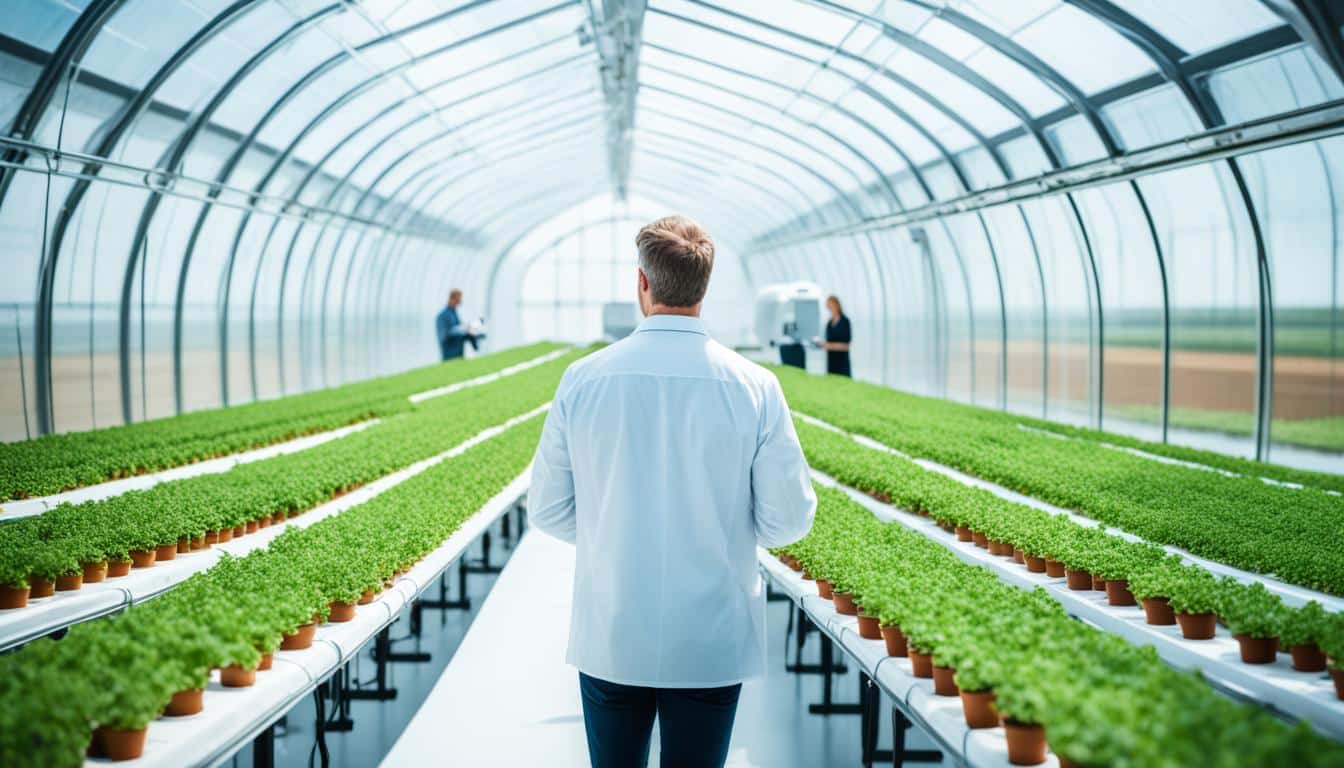
Costa Rica is a small country but is bursting with life. It has nearly 6.5% of all the species on Earth. This shows how agricultural biotech innovations can change farming. For 16 years, BioTech has led the way in sustainable food growing and fighting plant diseases.
New farming techniques are emerging thanks to biotechnology. This includes using gene editing and creating plants that resist bugs. These changes are making farming more efficient and better for the planet. For instance, in Costa Rica, adding Trichoderma spp. to pineapple farms increases the fruit yield by 10-12%. These achievements point to a greener, more efficient future in farming.
Modern farming has changed for the better with the help of agricultural biotech innovations. These new technologies make agriculture more sustainable, productive, and resilient. They tackle the challenges the farming industry faces in effective ways.
Agricultural biotechnology’s journey shows its power to connect old and new farming methods. *Genetic engineering* plays a big role. It allows us to grow crops that fight off harmful herbicides. This shows how useful biotech is in our fields.
Biotechnology has also made better and safer vaccines against serious animal diseases. Before, we used traditional breeding methods. Now, with molecular gene transfer, we can change genes quickly, precisely, and with more scope.
In today’s farming, enzymes that cut DNA are key. They help scientists analyze and make copies of individual genes. Vectors, like viruses and plasmids, are also important tools. They move genes between different living things, including animals, plants, and microbes.
| Year | Crop | Percentage GMO |
|---|---|---|
| 2020 | Soybeans | 94% |
| 2020 | Cotton | 96% |
| 2020 | Corn | 92% |
GMO crops, like soybeans, cotton, corn, sugar beets, and canola, are changing farming. These crops have been proven safe for us to eat. They also help us farm in ways that are better for our planet.
Important innovations in farming are often praised by leaders in companies like Johnson & Johnson, Roche, GSK, Syngenta, and Bayer. They include plants that can survive tough environments and new ways to make proteins. These innovations show how important and promising agricultural biotechnology is.
Genetic crop enhancements have changed farming for the better. They improve yields, quality, and the plant’s ability to withstand tough conditions. In recent times, genetic editing has opened up new paths for farming sustainably. These innovations are key to feeding the world and lessening harm to the environment.
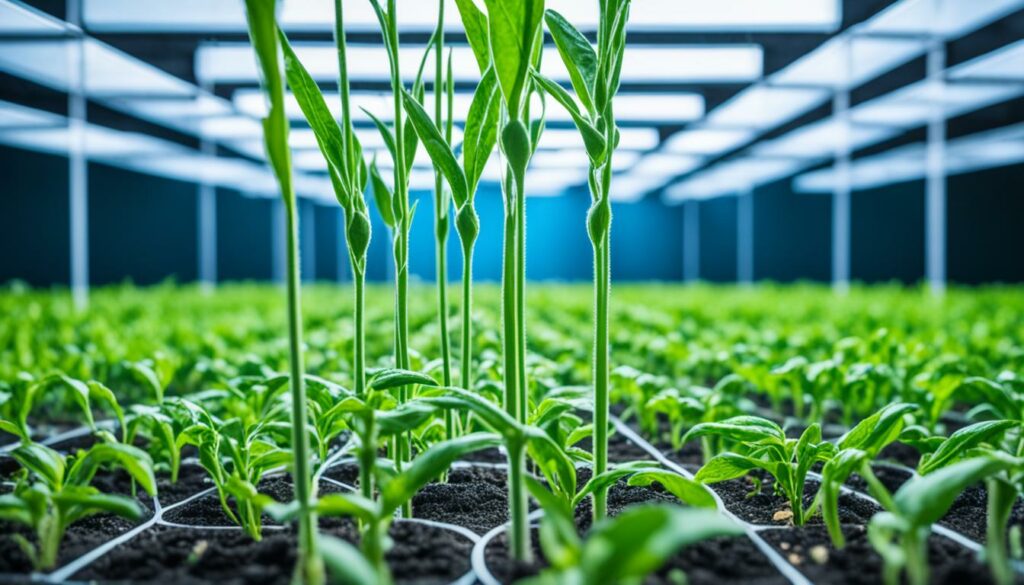
With genetic engineering, we can now grow more food. Scientists have created plants that give better harvests and survive different climates. This has increased how much food we can grow, like the famous green revolution did.
These genetically modified crops also fight off diseases and pack more nutrients. They help us aim for farming that lasts and is healthier in the 21st century.
Bioengineering has made plants that bugs don’t like to eat, cutting down on chemical use. This has made farming friendlier to the environment and more profitable. It shows how farming can be good for us and the planet at the same time.
Thanks to these engineered crops, farmers lose less to pests. This means more food and better quality for all of us.
Technologies like CRISPR are changing how we improve crops. With genome editing, scientists can change plant DNA very precisely. This new approach is faster and more direct than old ways of breeding.
It’s making farming stronger against pests and tough weather. Genetic editing is vital for making farming truly sustainable in the long run.
In today’s world, tackling climate change and feeding more people is vital. That’s why sustainable farming is so important. Approaches like regenerative agriculture are becoming more popular. They aim to improve soil, help plants and animals thrive, and keep the earth healthy.
Regenerative agriculture sees a farm as its own special place. It works on making the soil healthier and keeping water clean by using natural ways. By doing this, we get more food from the same land and help the planet. This way is a step towards farming that lasts for many years.
A key part of taking care of farms is using friends from nature to stop pests. This natural way lowers the use of harmful chemicals. It’s been found to make farms more stable, even when the weather changes a lot. This way, the land stays good for growing food.
Integrated Pest Management (IPM) is a smart mix of different ways to keep pests from hurting crops. It uses less harmful methods that are good for nature and us. By working together, these methods protect plants without causing long-term harm to the environment.
Using regenerative farming, natural pest controls, and IPM can change our future for the better. These methods offer a strong way to solve today’s farming problems. They help us make more food in a way that keeps our planet healthy.
Since 1986, the United States has been leading in agricultural technology. This started with the “Coordinated Framework for the Regulation of Biotechnology”. Since then, the U.S. has seen a big increase in farming technology.
This growth happened because of new plant types developed through biotechnology. It made the U.S. a global front runner in farming tech. Thanks to these new rules, the U.S. keeps moving forward in agricultural innovation.
The U.S. Department of Agriculture set new rules for biotech crops. This led to quick tests in the fields and fast use of new seed types. But, the U.S. Environmental Protection Agency’s advice on tiny organisms used in farming wasn’t as quick. This slowed down some technological growth.
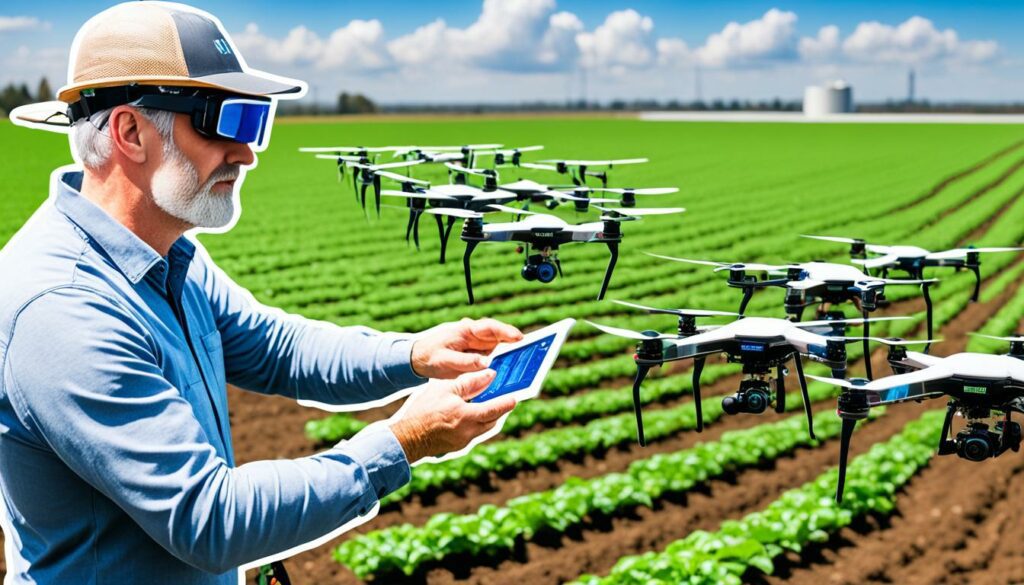
The Food and Drug Administration in the U.S. quickly checked the safety of food from biotech. This made these foods easier to use widely. But Europe was very strict with its rules on these new plants. They focused too much on one kind of technology. Many big companies then moved their research to the U.S.
But, even with these advancements, the U.S. still needs to update its rules. There’s a lot to learn from the past. New rules should focus on safety by looking at how big the risks are. They should also not try to get rid of all risks.
| Year | Event | Impact |
|---|---|---|
| 1986 | United States establishes Coordinated Framework for Biotechnology | Fostered rapid development of biotech plant varieties |
| 1990 | Europe adopts genetically engineered crop regulations | Caused regulatory hurdles; many companies moved R&D to the U.S. |
| 1995 | FDA provides guidance on safety of biotech foods | Accelerated commercial adoption of biotech foods |
Using new technologies is key for the growth of farming. Innovations like precision farming, data use, and better seeds help a lot. They make farming more efficient, increase what we get from it, manage risks better, and make choices smarter.
Updating the rules to support these new technologies is very important. We need to stop using old measures to decide what’s safe. Instead, we should base our decisions on real risks and make rules that help new ideas and science grow.
Bioengineering has helped crops become more resilient. This means they can withstand tough conditions better. Farmers can now grow crops that do well even when the weather is not nice. We’ll look at how these advances help make farming more environmentally friendly and productive.
There are now plants that can handle a changing climate. Scientists have been using tools like CRISPR to make plants tougher. They aim to increase crop yields even when disasters like droughts or floods hit.
Add to this the power of tiny living things. These tiny things can make soil better and help plants fight off diseases. They also help plants get more nutrients from the soil. So, farms can keep growing well, even when the environment is under stress.
Another big goal is to help crops deal with stress. Scientists use cutting-edge tools to make crops more stress-tolerant. This makes crops better at handling tough situations, like too much heat or not enough water. The goal is to make farming more stable and productive.
These advancements are changing the way we farm for the better.Learn more about these changes here.
Agricultural biotechnology is changing farming for the better, particularly in reducing environmental harm. An important advance is the creation of crops that can survive droughts. For instance, in the United States, corn that can bear dry conditions well is flourishing. It’s a similar story in Argentina and Brazil with their wheat. This shows a worldwide trend towards farming that copes well with climate changes.
The good from biotechnology doesn’t stop with dealing with droughts. Back in 2012, most of the corn, cotton, and soybeans grown in America were biotech types. These crops need fewer chemicals, reducing the harm from pesticides and herbicides. Cotton that bugs don’t like has helped cut pesticide use. This eases the pressure on our environment and health.
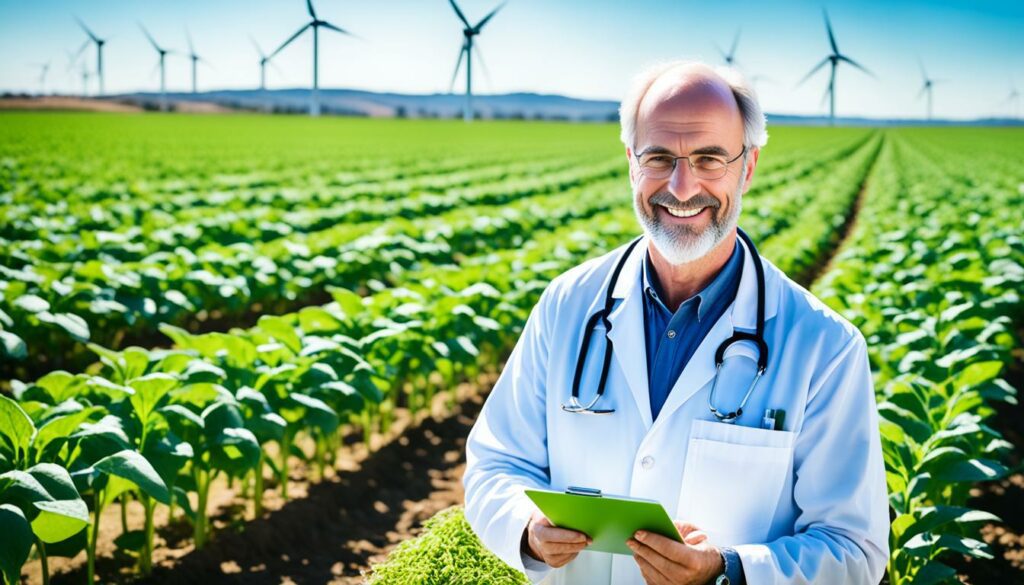
Biotech crops also make it possible to use herbicides that are safer for animals and people. This is better for taking care of our environment. Shifting to biotech crops means farmers can grow better produce and more of it. This has made farming more profitable.
In the U.S., farming and forestry made up a big part of greenhouse gas emissions in 2018. Agricultural biotechnology is working to lower these emissions. It uses things like precision farming and biopesticides to do this. That way, it’s helping to reduce the harm from chemicals too.
The ongoing support and strict checking from groups like the USDA, EPA, and FDA matter a lot. They make sure biotech crops are safe for us and the world. Plus, with the U.S. leading in farming innovation, the future of eco-friendly farming looks bright. This is great news for taking care of our planet.
Modern farming is getting a big boost from new techniques. These include using smart tech like the Internet of Things (IoT), Artificial Intelligence (AI), and Geographic Information Systems (GIS). They help make farming smarter and more productive.
Farm automation is changing the way we farm. By using biotechnology, tasks are easier and don’t need as much human work. Things like automated harvesters, drones, and self-driving tractors are at the core of these changes. They cut down on the time it takes to farm, boost crop growth, and make better use of resources.
Bee Vectoring Technologies (BVT) is showing how to protect crops without hurting the environment. Their system aims to hit the $20 billion U.S. crop market. They use green lasers to scare off birds, cutting crop damage by 70-90%.
Modern farming is going high-tech with the use of the Internet of Things (IoT) and Artificial Intelligence (AI). This leads to precise farming, where everything is closely monitored and analysed in real time. It helps farmers act quickly and make their crops healthier. This kind of farming is essential for the future, with the market expected to hit $16.35 billion by 2028.
Indoors, farming is also benefiting from these advances. Thanks to IoT and AI, crops are better and use less water. Robots are also used, making farming easier and cheaper.
GIS is transforming how we use land and manage farms. It’s great for mapping soil, keeping an eye on crops, and wisely using resources. With Real-Time Kinematic (RTK) technology, we get very accurate field maps. This makes farming more efficient and helps the soil stay healthy.
These techs are also helping with water use. By managing water smartly, we’re wasting less and dealing with the challenge of water scarcity in farming.
Here are some top tech innovations in farming and their big impacts:
| Technology | Benefits | Real-World Applications |
|---|---|---|
| Farm Automation | Reduces labour time, increases yields, efficient resource use | Automated harvesters, drones, autonomous tractors |
| IoT and AI | Real-time monitoring, data analysis, precision agriculture | Indoor vertical farming, robotics, crop health monitoring |
| Geographic Information Systems (GIS) | Soil mapping, crop monitoring, enhances productivity | RTK technology for field mapping, water management innovations |
New farming methods are making the industry more efficient. They help meet the world’s food needs and protect the environment. These advances mark a new chapter in farming.
Controlled Environment Agriculture (CEA) is changing the face of modern farming. It uses high-tech methods to farm in precise conditions. This makes the most of the space and uses resources carefully.
CEA includes methods like vertical farming and hydroponics. These let farmers grow top-notch crops no matter the weather. It’s great for cities, supports planet-friendly farming, and boosts crop amounts.
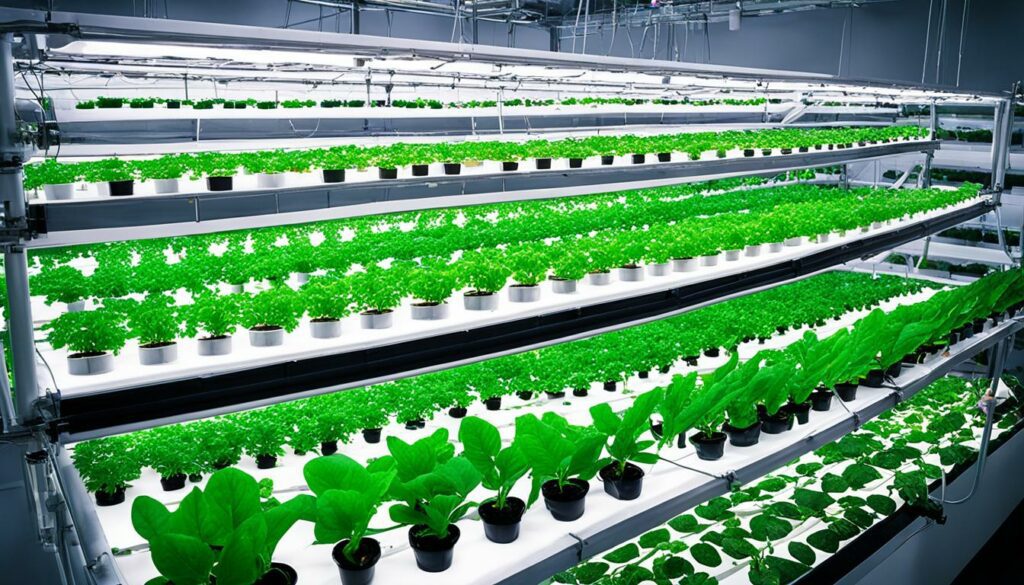
The rise of CEA is clear from the numbers in the U.S. Between 2009 and 2019, CEA farms shot up to nearly 3,000. In that time, the amount of crops grown in these settings jumped 56%. By 2019, most tomatoes, cucumbers, and lettuce in controlled environments used hydroponics.
This new farming model shows biotechnology’s power in solving farming problems. It has led to crops that can resist herbicides and insects. These are safer for us, wildlife, and the planet. Farmers use fewer harmful chemicals.
Biotech also helps make crops tougher against sickness and harsh conditions. These advances are making farms more sustainable and able to bounce back from troubles easier.
The table below shows key facts about CEA’s growth and effect in the U.S.:
| Year | Number of CEA Operations | Controlled Environment Crop Production (million pounds) | Main CEA Practices |
|---|---|---|---|
| 2009 | 1,500 | 502 | Vertical Farming, Hydroponics |
| 2019 | 3,000 | 786 | Vertical Farming, Hydroponics, Agrivoltaics |
The growth of CEA points to an encouraging future for high-tech farming. As these new methods get better, they can help make more food, stick to green practices, and support strong farming.
In agriculture, making the best use of nutrients is key for the planet. Biotech can help crops absorb nutrients better. This lowers harm to the environment.
We can now use genes to make crops take in nutrients more efficiently. This not only helps crops grow better but also deals with lack of nutrients. It makes farming more steady.
Biotech boosts how well crops use fertilisers. This lowers how much fertiliser we need and cuts down on nutrient waste. For example, special crops can resist weed killers, making farming easier without harming the earth. Also, there’s Golden Rice, which is full of important nutrients because of genetic work.
Here’s a table showing how much more cereal we’ve grown thanks to biotechnology:
| Year | Yield Growth (%) | Key Biotechnological Intervention |
|---|---|---|
| 1960-1990 | 100% | Introduction of High-Yield Varieties |
| 1990-2020 | 45% | CRISPR and Genetic Editing Technologies |
By the year 2030, the world will have many more people to feed. So, using biotech smartly is very important. This means combining better farming techniques with genetic changes for more food for everyone.
Climate change is a big challenge for farming. It forces us to find new ways to make our crops strong against the changing climate. Thanks to agricultural biotechnology, we’re able to develop crop systems that can withstand the harsh effects of climate change.
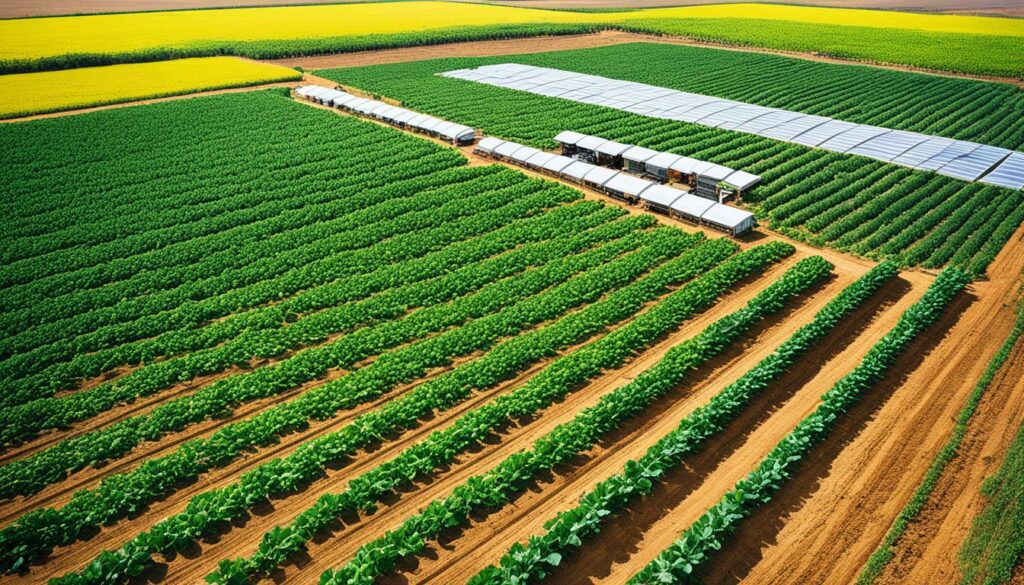
One major approach is creating drought-resistant crops. Scientists have used genetic tweaks to make plants that don’t need as much water. This helps tackle the problem of not enough rain, worsened by climate change. Institutions like Ullstrup AJ point out the importance of having a variety of crops to fight against this challenge.
High soil salt, also known as salinity, is bad for crops. It makes the land less fertile. Researchers are using biotechnology to make crops that can handle salty soil better. Thanks to work by Khoury CK and others, we know that saving different crop types is key to having salt-loving crops.
Beating the heat and the cold is also crucial for our crops. As extreme weather gets more common, our plants need to adapt. By mixing genes and using new science methods, we now have crops that can brave the weather ups and downs. Recent studies, like those by Fenzi M and Bonneuil C, support the need for these resilient crops.
It’s a team effort to make our farms ready for the future. The work of scientists, big groups, and everyday people is vital. Projects by the Agricultural Biotech Innovations group, working with places like the University of Wisconsin-Platteville and big names like Bayer and DSM, push these important changes forward.
| Aspect | Method | Impact |
|---|---|---|
| Drought Resistance | Genetic Modification | Increased Yield in Water-Scarce Areas |
| Salinity Tolerance | Biotechnological Advancements | Enhanced Crop Productivity in High Salinity Soils |
| Temperature Extremes Tolerance | Bioengineering | Resilience to Heatwaves and Cold Spells |
To wrap up, preparing our crops for droughts, salty lands, and wild weather is essential. Through combining global policies, hard research, and creative solutions, we can ensure our farms thrive no matter what climate change brings.
Biofortification is a big step in dealing with public health and malnutrition. It aims to make crops more nutritious. This helps improve diets, especially in areas where there’s not much food variety.
A review found that biofortified crops directly improve health. They are bought directly by people or eaten indirectly. Also, they are used in formal settings and in farmer households.
HarvestPlus has introduced many biofortified crops in over 100 countries. They show that this method is sustainable. It’s not expensive to keep it going once these crops are out there.
Biofortification beats other ways of adding nutrients to food. It makes sure both rural and city people get healthier food. This is key in fighting against not getting enough nutrients, which is a big problem worldwide.
Studies suggest that biofortification helps fight malnutrition and is cost-effective. It’s seen as a smart way to make food more nutritious.
| Study | Focus | Findings |
|---|---|---|
| McGuire (2015) | Food Insecurity | Highlighted uneven progress in international hunger targets |
| Muthayya et al. (2013) | Hidden Hunger | Revealed global hidden hunger indices for advocacy |
| Khush et al. (2012) | Malnutrition | Emphasized biofortification to reduce malnutrition |
| Gilani and Nasim (2007) | Nutritional Enhancement | Impact on alleviating malnutrition through biotechnology |
| Bouis (1999) | Economics | Explored costs and benefits of enhancing micronutrient density |
| Meenakshi et al. (2010) | Cost-Effectiveness | Assessed cost-effectiveness of biofortification |
In the end, biofortification uses genetic improvement in plants to tackle food insecurity. Success stories, like Golden Rice, show the huge impact biofortified crops can have on health.
Agricultural biotechnology is making great strides with its real-life success stories. These stories shine a light on how it’s shaping sustainable farming and global agriculture. They show the world the positive impact of biotechnology.
BioTech S.A. is leading in using biotechnology to protect our environment. They create crops that can fight off pests and diseases without harming the Earth. Their work has led to healthier soil and more crops for farmers, all while being eco-friendly.
Costa Rica is a role model in farming with the environment in mind. They have embraced biotechnology. This adoption has improved soil and helped create crops that need less water, are more nutritious, and eco-friendlier.
The impact of these stories stretches worldwide, showing the power of biotechnology. It is widely used, with 80% of processed foods containing its derived ingredients. Moreover, biotechnology is helping cut down on harmful emissions from fuels.
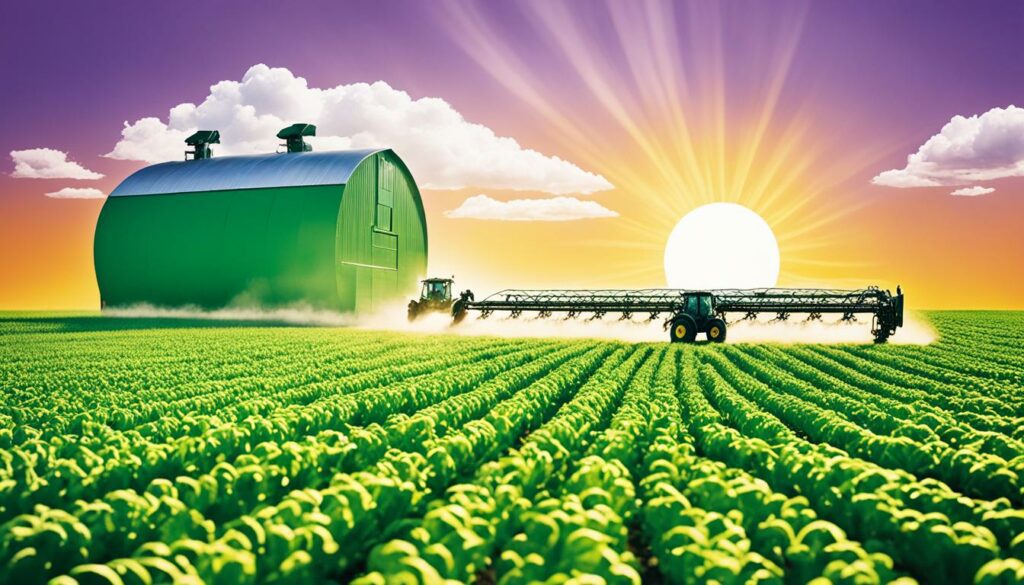
The future for agricultural biotechnology is bright. It’s set to make crops tougher, food more secure, and our environment safer. As these success stories tell us, the path to a better future in agriculture lies in innovation.
The world’s need for food will jump by 70% by 2050 because more people will be alive. To tackle this big issue, we will see huge changes in farming technology. Biotechnology plays a key role here, promising better crop yields and making crops tougher.
A big part of agriculture’s future is using AI, IoT, and automation together. This set-up is making precision agriculture possible, a field set to hit $43.4 billion by 2025. With Real-Time Kinematic (RTK) technology, farmers can make sure their work is precise to the centimetre, cutting down waste and using resources better.
Indoor vertical farming is also a big deal, aiming to cut water use by 70% when compared to the usual way of farming. This meets a worldwide need to save water. Add in minichromosome technology, and you get plants that are hardier without messing with their natural development. These methods offer a more eco-friendly path for farming.
Farm automation is bringing in bigger crops in less time. For example, laser scarecrows can cut down on crop damage by 70%-90%. This shows how technology can effectively protect farming produce.
“Approximately 9.9% of the world’s population still faces hunger challenges. Advanced agricultural technologies promise to tackle these issues by optimising production and resource management.”
Putting money into the future of farming tech is also vital. The global demand for precise farming aims to get at $16.35 billion by 2028, growing by 13.1% every year. This shows a strong worldwide push to make farming more efficient and eco-friendly.
Plug and Play’s Agtech platform is key in this growth. It helps new companies with advice, connects them with others, and gives them a chance to pitch and get funds. These efforts help new farming technology to make a mark.
Indoor farms that grow in height use 70% less water than usual, and they’re part of a nearly $350 billion market for vegetables every year. Management software for farms is expected to grow by 11.2% by 2026. This will make running farms smarter and more effective.
New ways to handle water on farms are also important. They aim to use water better and stop it from being wasted. The ongoing growth in these areas highlights the need for new ways of farming to last over time.
| Technology/Innovation | Impact |
|---|---|
| Artificial Intelligence (AI) & IoT | Enhanced decision-making, real-time monitoring, precision agriculture |
| Indoor Vertical Farming | Reduces water usage by up to 70%, maximises space efficiency |
| Farm Automation | Higher yields, reduced labour time |
| Laser Scarecrows | Reduces crop damage by 70%-90% |
| RTK Technology | Provides centimetre-level accuracy |
In conclusion, the advances in farming tech aren’t just exciting; they’re needed. They will help us grow enough food for a growing world while farming in ways that are good for the planet. From using AI to farm more precisely, to vertical farms and more, new technology is changing and securing the future of farming.
The rise of agricultural biotech is changing farming in big ways. It brings benefits like crops that resist disease and need fewer nutrients. These can help us farm in ways that are kinder to the planet. We need to keep making these technologies work for everyone by being affordable and fitting different needs.
Bright spots around the world show how well biotech can work. Take India, for example. It’s helped 126 countries share new genetic plant improvements thanks to a UNEP-GEF project. In Egypt, making insulin locally for two years proves we can rely on our own bioengineering skills. And Cuba’s work on a vaccine against meningitis B shows biotech is key for public health.
In the future, we’ll see even more from biotech. Techniques like RNA interference and gene editing are already helping grow tougher plants. Places like Brazil are focusing on deepening their scientific knowledge. Meanwhile, China and Cuba show how important it is to have strong support from governments and worldwide partnerships. With these steps, agriculture can become both greener and more productive, securing a sustainable tomorrow.
Agricultural biotech innovations use new biological and technological developments. They aim to make farming more sustainable, productive, and resilient. This includes using genetic modification and new bioengineering methods.
Genetic crop enhancements boost farm production in big ways. By using genetic and bioengineering, crops are designed to yield more. They also resist pests better. For instance, CRISPR makes it possible to edit genes precisely, creating strong and sustainable crops.
There’s regenerative agriculture, which helps soil and boosts biodiversity. It includes methods that don’t harm the environment. For example, using biological pest control and careful pest management.
Technology, such as precision farming, is changing farming for the better. It makes farming more efficient, boosts harvests, and helps manage risks. These tools are key in making smart choices in farming.
For making crops tougher against the weather, there’s a lot of work being done. This includes growth of varieties that handle climate changes and soil interventions. It also involves making crops better at dealing with droughts, high salt levels, and extreme heat.
Agricultural biotechnology is vital for lessening the strain on our planet. It allows for farming that doesn’t use up as many resources. It cuts down on greenhouse gases, water usage, and chemical pollution. This helps to take better care of our environment.
Right now, farming is getting a tech upgrade. This includes using biotechnology in farming and smart tools like IoT and AI. We’re also using advanced mapping for our crops and land.
Controlled Environment Agriculture focuses on controlled farming environments. Some methods used are vertical farming and hydroponics. These save space, use less water, and don’t depend on the weather for growing crops.
To make the most of nutrients, we use genetic enhancement and new biotech. This means crops can use nutrients better. It cuts down on the need for lots of fertilisers, which helps protect the environment.
Crops are being made to withstand tough climates. They’re being designed to handle drought or salty soils. They’re also getting better at surviving extreme heat and cold. This helps make sure our food stays safe from environmental harm.
Biofortification makes crops more nutritious. This helps fight poor nutrition and improves health. It’s a lasting way to tackle the lack of varied foods in some places. It does a lot for the health of many people.
BioTech S.A. is among those leading biotech for a greener future. Their work helps both biodiversity and soil health. In Costa Rica, advanced farming shows how vital biotechnology is for the future. These success stories let us see the great impact and potential of biotech.
The future of farming tech looks bright. AI, IoT, and automation will keep getting better. These, along with new genetic tricks and eco-friendly practices, will make farming strong, efficient, and bountiful.